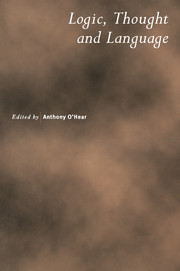Book contents
- Frontmatter
- Contents
- Preface
- Notes on Contributors
- What logic should we think with?
- Mental Representation and Mental Presentation
- Self-knowledge, Normativity, and Construction
- The Normativity of Meaning
- Two Theories of Names
- Relativism and Classical Logic
- Principles for Possibilia
- What are these Familiar Words Doing Here?
- Particular Thoughts & Singular Thought
- Conditional Belief and the Ramsey Test
- Necessary Existents
- Ambiguity and Belief
- Basic Logical Knowledge
- Frege's Target
- Index
Particular Thoughts & Singular Thought
Published online by Cambridge University Press: 05 October 2010
- Frontmatter
- Contents
- Preface
- Notes on Contributors
- What logic should we think with?
- Mental Representation and Mental Presentation
- Self-knowledge, Normativity, and Construction
- The Normativity of Meaning
- Two Theories of Names
- Relativism and Classical Logic
- Principles for Possibilia
- What are these Familiar Words Doing Here?
- Particular Thoughts & Singular Thought
- Conditional Belief and the Ramsey Test
- Necessary Existents
- Ambiguity and Belief
- Basic Logical Knowledge
- Frege's Target
- Index
Summary
A long-standing theme in discussion of perception and thought has been that our primary cognitive contact with individual objects and events in the world derives from our perceptual contact with them. When I look at a duck in front of me, I am not merely presented with the fact that there is at least one duck in the area, rather I seem to be presented with this thing (as one might put it from my perspective) in front of me, which looks to me to be a duck. Furthermore, such a perception would seem to put me in a position not merely to make the existential judgment that there is some duck or other present, but rather to make a singular, demonstrative judgment, that that is a duck. My grounds for an existential judgment in this case derives from my apprehension of the demonstrative thought and not vice versa.
The cognitive role of experience is also mirrored in its phenomenology: that I am presented with a particular rubber duck, or a particular event of, say, the duck coming off the production line, is reflected in how things now visually appear to me. It looks to me as if there is a particular object before me, or that some given unrepeatable event is occurring. Hence we should expect a theory of sensory experience which aims to give an adequate account of phenomenology to accommodate and explain how such experience can indeed be particular in character.
- Type
- Chapter
- Information
- Logic, Thought and Language , pp. 173 - 214Publisher: Cambridge University PressPrint publication year: 2002
- 23
- Cited by

